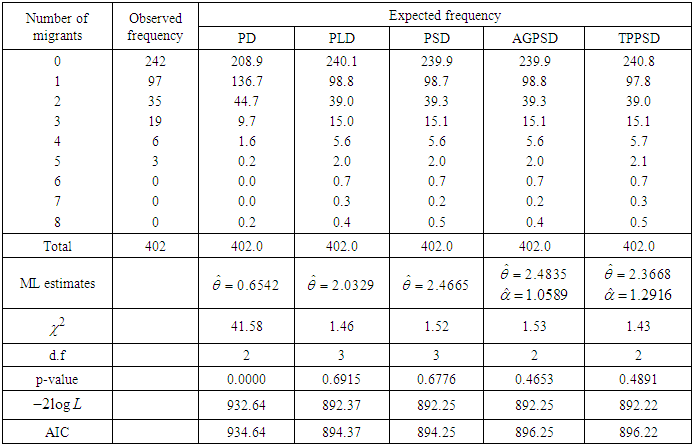-
Paper Information
- Previous Paper
- Paper Submission
-
Journal Information
- About This Journal
- Editorial Board
- Current Issue
- Archive
- Author Guidelines
- Contact Us
American Journal of Mathematics and Statistics
p-ISSN: 2162-948X e-ISSN: 2162-8475
2020; 10(3): 70-78
doi:10.5923/j.ajms.20201003.02

A Two-Parameter Poisson-Sujatha Distribution
Rama Shanker 1, Kamlesh Kumar Shukla 2, Tekie Asehun Leonida 3
1Department of Statistics, Assam University, Silchar, India
2Department of Statistics, Mainefhi College of Science, Asmara, Eritrea
3Department of Applied Mathematics, University of Twente, The Netherlands
Correspondence to: Rama Shanker , Department of Statistics, Assam University, Silchar, India.
| Email: |  |
Copyright © 2020 The Author(s). Published by Scientific & Academic Publishing.
This work is licensed under the Creative Commons Attribution International License (CC BY).
http://creativecommons.org/licenses/by/4.0/

A two-parameter Poisson-Sujatha distribution which is a Poisson mixture of two-parameter Sujatha distribution, and includes Poisson-Sujatha distribution as particular case has been proposed. Its moments and moments based measures including coefficient of variation, skewness, kurtosis and index of dispersion have been obtained. Maximum likelihood estimation has been explained for estimating its parameters. Goodness of fit of the proposed distribution has been explained with two over-dispersed count datasets and the fit has been compared with one parameter Poisson-Lindley distribution and Poisson-Sujatha distribution and a generalization of Poisson-Sujatha distribution.
Keywords: Sujatha distribution, Poisson-Sujatha distribution, Two-parameter Sujatha distribution, Moments based measures, Maximum likelihood estimation
Cite this paper: Rama Shanker , Kamlesh Kumar Shukla , Tekie Asehun Leonida , A Two-Parameter Poisson-Sujatha Distribution, American Journal of Mathematics and Statistics, Vol. 10 No. 3, 2020, pp. 70-78. doi: 10.5923/j.ajms.20201003.02.
Article Outline
1. Introduction
- In statistics literature, Poisson distribution is the common distribution for modeling count data. However, the unique feature of equality of the mean and the variance (equi-dispersed) of Poisson distribution makes it unsuitable for modeling count data which are under-dispersed (mean greater than variance) or over-dispersed (mean less than variance). In recent years, several researchers have proposed Poisson mixture of lifetime distributions which are useful for over-dispersed or under-dispersed. The over-dispersed Poisson mixed distributions are Poisson-Lindley distribution (PLD), a Poisson mixture of Lindley distribution of Lindley (1958) proposed by Sankaran (1970), Poisson-Sujatha distribution (PSD), a Poisson mixture of Sujatha distribution of Shanker (2016 a) introduced by Shanker (2016 b), some among others. The probability density function (pdf) of Sujatha distribution having scale parameter
 and introduced by Shanker (2016 a) is
and introduced by Shanker (2016 a) is  | (1.1) |
 | (1.2) |
 , gamma
, gamma  and gamma
and gamma  distributions and defined by its pdf
distributions and defined by its pdf | (1.3) |
 is a scale parameter and
is a scale parameter and  is a shape parameter. Lindley distribution and Sujatha distribution are the particular cases of AGSD for
is a shape parameter. Lindley distribution and Sujatha distribution are the particular cases of AGSD for  and
and  , respectively. Various statistical properties, estimation of parameters and applications of AGSD have been discussed by Shanker et al (2017).Shanker and Shukla (2019) derived a generalization of Poisson-Sujatha distribution (AGPSD) by mixing Poisson distribution with AGSD. The AGPSD is defined by its pmf
, respectively. Various statistical properties, estimation of parameters and applications of AGSD have been discussed by Shanker et al (2017).Shanker and Shukla (2019) derived a generalization of Poisson-Sujatha distribution (AGPSD) by mixing Poisson distribution with AGSD. The AGPSD is defined by its pmf  | (1.4) |
 and
and  , respectively. Statistical properties based on moments, unimodality and increasing hazard rate, estimation of parameter and applications of AGPSD have been studied by Shanker and Shukla (2019). Mussie and Shanker (2018) proposed a two-parameter Sujatha distribution (TPSD) defined by its pdf
, respectively. Statistical properties based on moments, unimodality and increasing hazard rate, estimation of parameter and applications of AGPSD have been studied by Shanker and Shukla (2019). Mussie and Shanker (2018) proposed a two-parameter Sujatha distribution (TPSD) defined by its pdf | (1.3) |
 is a scale parameter and
is a scale parameter and  is a shape parameter. It can be easily verified that (1.3) reduces to Sujatha distribution (1.1) and size-biased Lindley distribution (SBLD) for
is a shape parameter. It can be easily verified that (1.3) reduces to Sujatha distribution (1.1) and size-biased Lindley distribution (SBLD) for  and
and  respectively.The main motivation for proposing a two-parameter Poisson-Sujatha distribution (TPPSD) are (i) Sujatha distribution is a better model than both exponential and Lindley distribution for modeling lifetime data, and PSD being a Poisson mixture of Sujatha distribution gives better fit than both Poisson and Poisson-Lindley distribution (PLD), and (ii) TPSD gives much better fit than exponential, Lindley and Sujatha distribution, it is expected that TPPSD being a Poisson mixture of TPSD would provide better fit over PLD, PSD and other discrete distributions. Keeping these points in mind, a two-parameter Poisson-Sujatha distribution (TPPSD), a Poisson mixture of TPSD has been proposed and its moments and moments based measures have been obtained and their behaviors have been studied. Maximum likelihood estimation of TPPSD has been discussed for the estimation its parameters and its applications have been discussed with two examples of observed count datasets from ecology and demography.
respectively.The main motivation for proposing a two-parameter Poisson-Sujatha distribution (TPPSD) are (i) Sujatha distribution is a better model than both exponential and Lindley distribution for modeling lifetime data, and PSD being a Poisson mixture of Sujatha distribution gives better fit than both Poisson and Poisson-Lindley distribution (PLD), and (ii) TPSD gives much better fit than exponential, Lindley and Sujatha distribution, it is expected that TPPSD being a Poisson mixture of TPSD would provide better fit over PLD, PSD and other discrete distributions. Keeping these points in mind, a two-parameter Poisson-Sujatha distribution (TPPSD), a Poisson mixture of TPSD has been proposed and its moments and moments based measures have been obtained and their behaviors have been studied. Maximum likelihood estimation of TPPSD has been discussed for the estimation its parameters and its applications have been discussed with two examples of observed count datasets from ecology and demography.2. A Two-Parameter Poisson-Sujatha Distribution
- A random variable
 is said to follow a two-parameter Poisson-Sujatha distribution (TPPSD) if
is said to follow a two-parameter Poisson-Sujatha distribution (TPPSD) if  and
and  . That is,
. That is,  , and
, and  The pmf of unconditional random variable
The pmf of unconditional random variable  can be obtained as
can be obtained as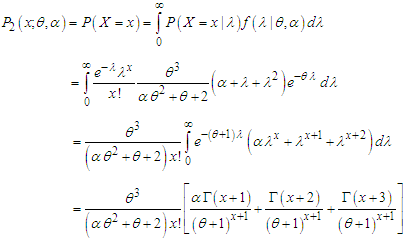 | (2.1) |
 | (2.2) |
 , it reduces to one parameter PSD given in (1.2). It can be easily shown that TPPSD is unimodal and has increasing hazard rate. Since
, it reduces to one parameter PSD given in (1.2). It can be easily shown that TPPSD is unimodal and has increasing hazard rate. Since  is decreasing function in
is decreasing function in  is log-concave. Now using the results of relationship between log-concavity, unimodality and increasing hazard rate (IHR) of discrete distributions available in Grandell (1997), it can concluded that TPPSD has an increasing hazard rate and unimodal. The behavior of the pmf of TPPSD for varying values of parameters
is log-concave. Now using the results of relationship between log-concavity, unimodality and increasing hazard rate (IHR) of discrete distributions available in Grandell (1997), it can concluded that TPPSD has an increasing hazard rate and unimodal. The behavior of the pmf of TPPSD for varying values of parameters  and
and  are shown in figure 1.
are shown in figure 1. 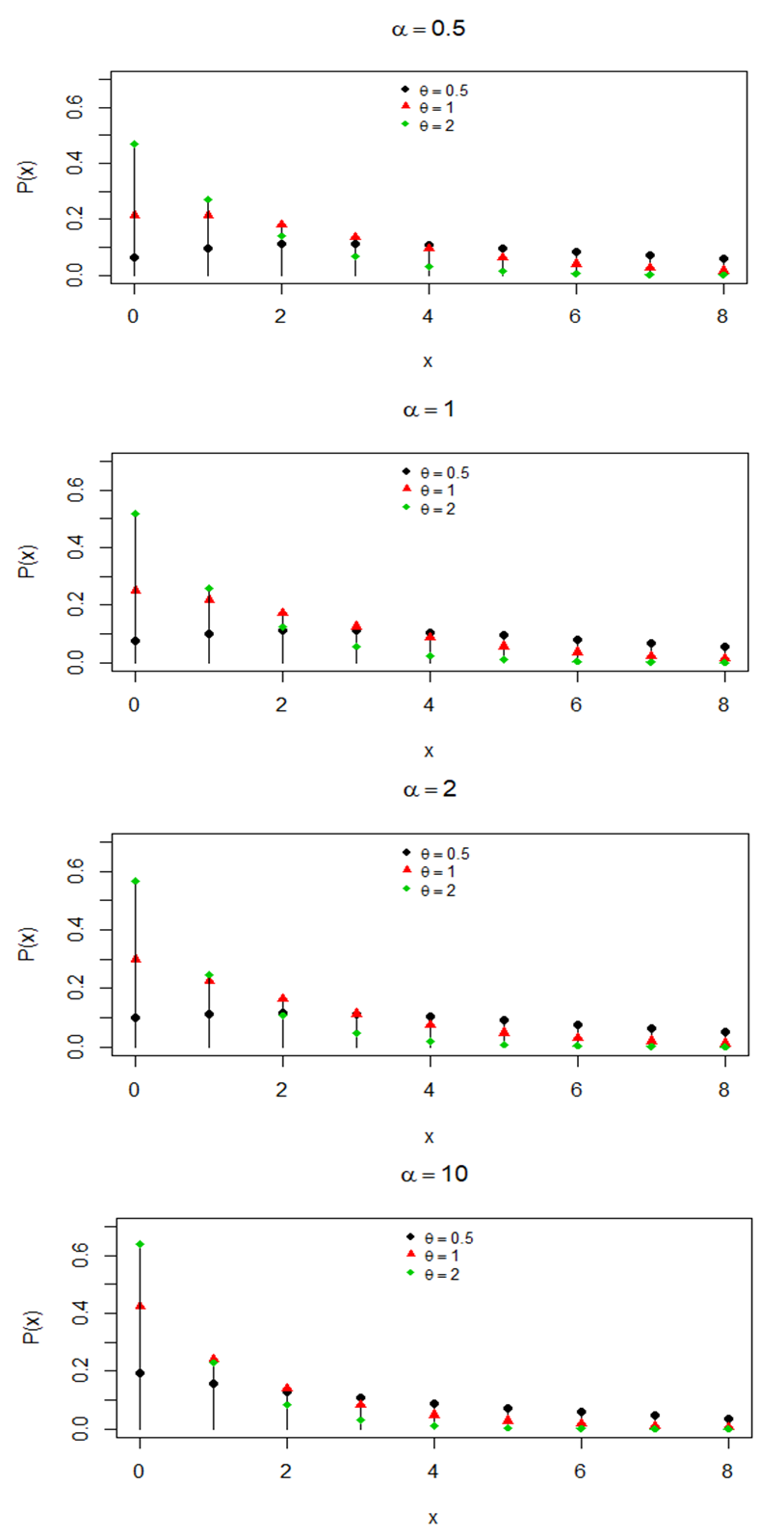 | Figure 1. Behaviour of pmf of TPPSD for varying values of parameters  and and  |
3. Moments Based Measures
- The
 factorial moment about origin
factorial moment about origin  of TPPSD (2.2) can be obtained as
of TPPSD (2.2) can be obtained as  , where
, where  . Using (2.1), the
. Using (2.1), the  factorial moment about origin
factorial moment about origin  of TPPSD (2.2) can be obtained as
of TPPSD (2.2) can be obtained as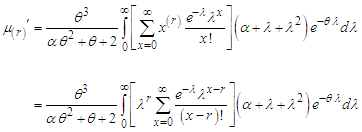 Taking
Taking  within the bracket, we get
within the bracket, we get 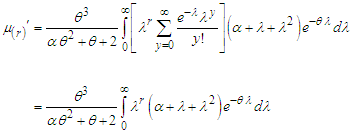 After some tedious algebraic simplification, a general expression for the
After some tedious algebraic simplification, a general expression for the  factorial moment about origin
factorial moment about origin  of TPPSD (2.2) can be expressed as
of TPPSD (2.2) can be expressed as | (3.1) |
 , the expression (3.1) reduces to the corresponding expression of PSD. Substituting
, the expression (3.1) reduces to the corresponding expression of PSD. Substituting  in (3.1), the first four factorial moments about origin of TPSD can be obtained as
in (3.1), the first four factorial moments about origin of TPSD can be obtained as Now using the relationship between factorial moments about origin and moments about origin, the first four moment about origin of the TPPSD are obtained as
Now using the relationship between factorial moments about origin and moments about origin, the first four moment about origin of the TPPSD are obtained as  Using the relationship between moments about mean and the moments about origin, the moments about mean of TPPSD are obtained as
Using the relationship between moments about mean and the moments about origin, the moments about mean of TPPSD are obtained as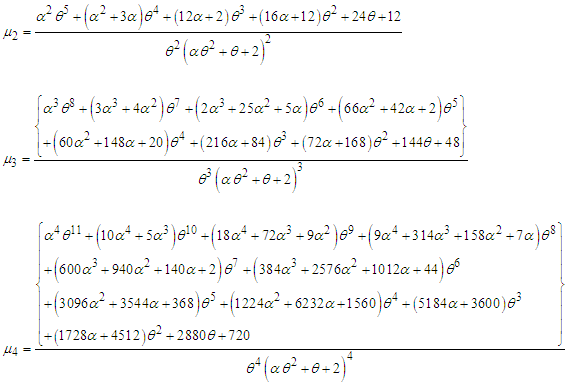 The coefficient of variation
The coefficient of variation  , coefficient of Skewness
, coefficient of Skewness  , coefficient of Kurtosis
, coefficient of Kurtosis  , and index of dispersion
, and index of dispersion  of TPPSD are thus given by
of TPPSD are thus given by 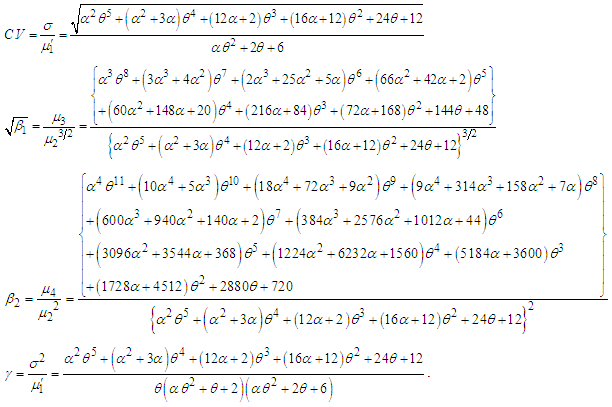 It can be easily verified that at
It can be easily verified that at  , expressions of these statistical constants of TPPSD reduce to the corresponding expressions for PSD. The behaviors of coefficient of variation (C.V), coefficient of skewness (C.S), coefficient of kurtosis (C.K) and index of dispersion (I.D) of TPPSD for varying values of parameters
, expressions of these statistical constants of TPPSD reduce to the corresponding expressions for PSD. The behaviors of coefficient of variation (C.V), coefficient of skewness (C.S), coefficient of kurtosis (C.K) and index of dispersion (I.D) of TPPSD for varying values of parameters  and
and  have been explained through graphs and presented in figure 2.
have been explained through graphs and presented in figure 2.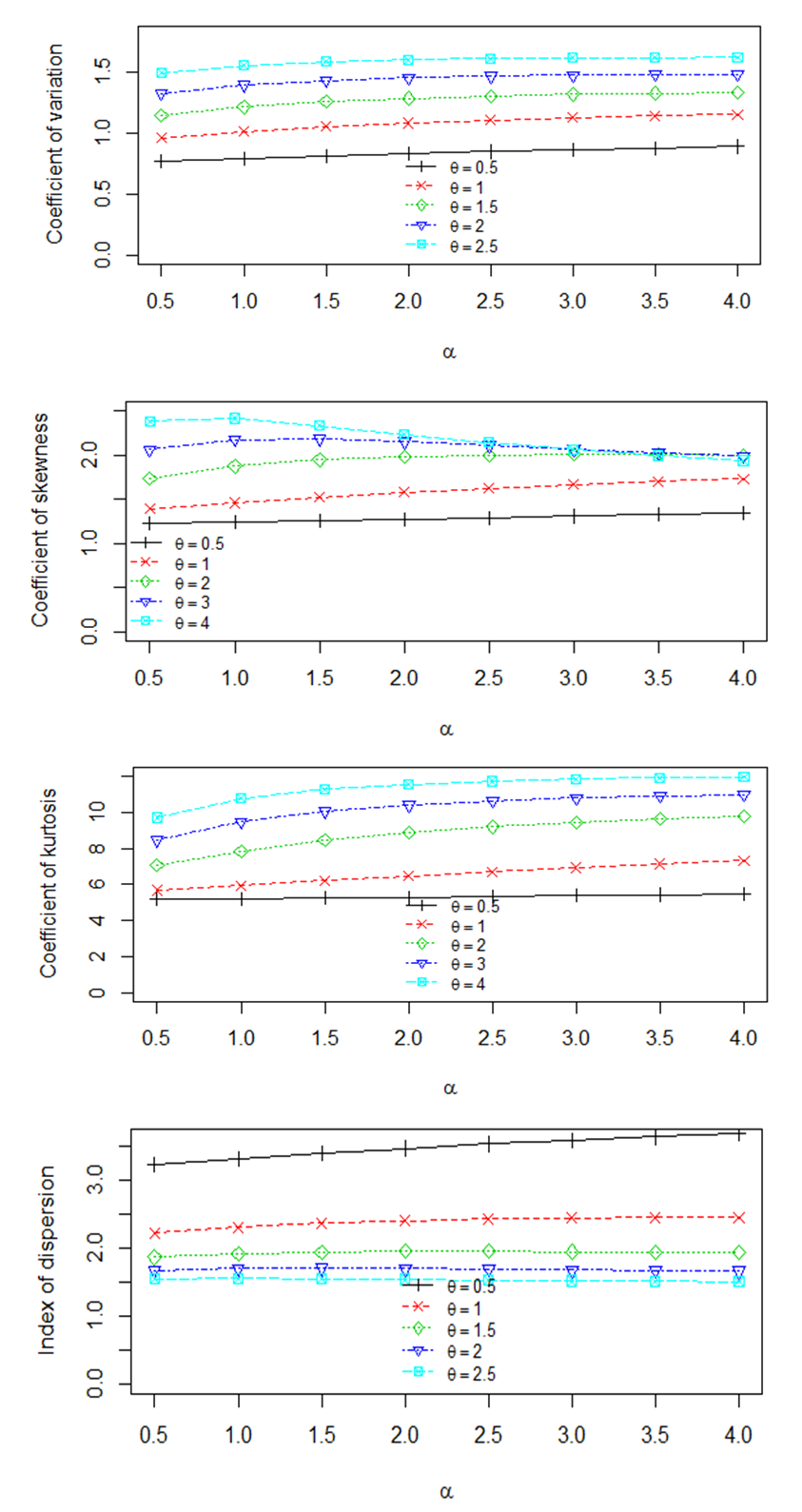 | Figure 2. Behaviors of coefficient of variation (C.V), coefficient of skewness (C.S), coefficient of kurtosis (C.K) and index of dispersion (I.D) of TPPSD for varying values of parameters  and and  |
4. Maximum Likelihood Estimation of Parameters
- Suppose
 be a random sample of size
be a random sample of size  from TPPSD and
from TPPSD and  be the observed frequency in the sample corresponding to
be the observed frequency in the sample corresponding to  such that
such that  , where
, where  is the largest observed value having non-zero frequency. The likelihood function
is the largest observed value having non-zero frequency. The likelihood function  of TPPSD is given by
of TPPSD is given by The log likelihood function is thus obtained as
The log likelihood function is thus obtained as The maximum likelihood estimates
The maximum likelihood estimates  of
of  of TPPSD is the solutions of the following log likelihood equations
of TPPSD is the solutions of the following log likelihood equations 
 where
where  is the sample mean. These two log likelihood equations do not seem to be solved directly because they do not have closed forms. Therefore, to find the maximum likelihood estimates of parameters an iterative method such as Fisher Scoring method, Bisection method, Regula Falsi method or Newton-Raphson method can be used. In this paper Newton-Raphson method has been used using R-software.
is the sample mean. These two log likelihood equations do not seem to be solved directly because they do not have closed forms. Therefore, to find the maximum likelihood estimates of parameters an iterative method such as Fisher Scoring method, Bisection method, Regula Falsi method or Newton-Raphson method can be used. In this paper Newton-Raphson method has been used using R-software.
|
|
5. Applications
- The applications and the goodness of fit of the TPPSD have been demonstrated with two real count datasets. The first dataset is from ecology regarding the observed number of European red mites on Apple leaves, available in Bliss (1953) and the second dataset is from demography regarding the observed number of households according to the number of male migrants aged 15 years and above, available in Shukla and Yadav (2006). These two datasets are over-dispersed data. Maximum likelihood estimation has been used to fit Poisson distribution (PD), Poisson-Lindley distribution (PLD), PSD, AGPSD and TPPSD. The AIC (Akaike information criterion) has been calculated using the formula
 , where
, where  is the number of parameters involved in the distribution. The distribution having less value of chi-square and AIC is the better distribution. Based on the values of chi-square and AIC of the considered distribution, it is obvious that TPPSD is competing well with the considered one parameter and two-parameter discrete distributions and, therefore, TPPSD can be considered an important two-parameter discrete distribution for ecology and migration data.
is the number of parameters involved in the distribution. The distribution having less value of chi-square and AIC is the better distribution. Based on the values of chi-square and AIC of the considered distribution, it is obvious that TPPSD is competing well with the considered one parameter and two-parameter discrete distributions and, therefore, TPPSD can be considered an important two-parameter discrete distribution for ecology and migration data.6. Concluding Remarks
- In this paper, a two-parameter Poisson Sujatha distribution (TPPSD) by compounding Poisson distribution with two-parameter Sujatha distribution, which includes Poisson-Sujatha distribution (PSD) as a special case, has been proposed. The unimodality and increasing hazard rate properties of the distribution has been explained. Its moments and moments based measures have been derived. The nature of coefficients of variation, skewness, kurtosis and index of dispersion has been discussed with varying values of parameters. The method of maximum likelihood estimation has been discussed. The applications of the proposed distribution has been explained through two examples of count data, one from ecology and one from demography and its goodness of fit has been found quite satisfactory over PD, PLD, PSD, and AGPSD.
ACKNOWLEDGEMENTS
- Authors are grateful to the editor in chief of the journal and the anonymous reviewer for constructive comments which were helpful in improving the quality and the presentation of the paper.
 Abstract
Abstract Reference
Reference Full-Text PDF
Full-Text PDF Full-text HTML
Full-text HTML
